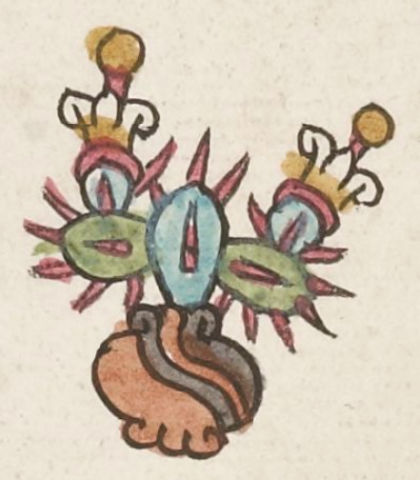Tenochtitlan (TR37r)
This compound glyph for the place name Tenochtitlan ("By the Rock Cactus"), the imperial capital city, shows a frontal view of a blooming, spiny, nopal cactus (nochtli) in multiple colors. The cactus is on a vertical stone (tetl), with its curling ends both up and down and its wavy, parallel lines of purple and terracotta cutting across the main part of the stone. The locative suffix (-titlan) is not shown visually in this compound.
Stephanie Wood
The translation, "By the Rock Cactus," comes from Gordon Whittaker, Deciphering Aztec Hieroglyphs, 2021, 111.
1578
Jeff Haskett-Wood
ciudades, cities, capitals, nopales, piedras, altepetl, nombres de lugares

Tenochtitlan, On the Cactus of the Stone, https://nahuatl.wired-humanities.org/content/tenochtitlan
tetl, stone, https://nahuatl.wired-humanities.org/content/tetl-0
nopalli, nopal, prickly pear cactus, https://nahuatl.wired-humanities.org/content/nopalli
"By the Rock Cactus" [Gordon Whittaker, Deciphering Aztec Hieroglyphs, 2021, 111]. "Place of the Cactus Fruit on the Stone" [Jongsoo Lee, The Allure of Nezahualcoyotl, 2008, 258.]
En el Tunal de la Piedra
Frances Karttunen
The Codex Telleriano-Remensis is hosted on line by the Bibliothèque nationale de France.
https://gallica.bnf.fr/ark:/12148/btv1b8458267s/f99.item. We have taken this detail shot from the indicated folio.
This manuscript is not copyright protected, but please cite Gallica, the digital library of the Bibliothèque nationale de France or cite this Visual Lexicon of Aztec Hieroglyphs, ed. Stephanie Wood (Eugene, Ore.: Wired Humanities Projects, 2020–present).





